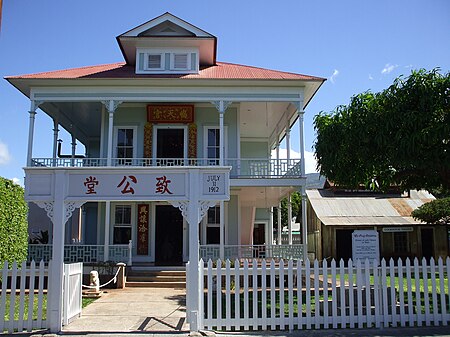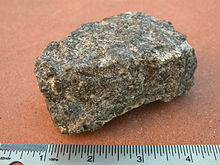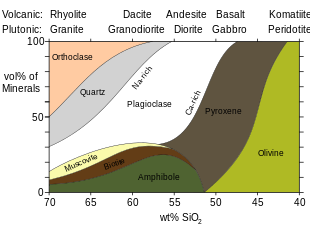Gabbro
|
Read other articles:

جامع سيد سلطان علي الجامع في عام 1918 إحداثيات 33°19′57″N 44°23′54″E / 33.3324°N 44.3983°E / 33.3324; 44.3983 معلومات عامة القرية أو المدينة بغداد / الرصافة الدولة العراق تاريخ بدء البناء 998هـ/ 1590م المواصفات المساحة 1000م2 عدد المصلين 100 عدد المآذن 1 التفاصيل التقنية المواد المستخدمة �…

Look up H, h, or aitch in Wiktionary, the free dictionary. H is the eighth letter of the Latin alphabet. H may also refer to: Musical symbols H number, Harry Halbreich reference mechanism for music by Honegger and Martinů H, B (musical note) H, B major People H. (noble) (died after 1279), an unidentified nobleman in the Kingdom of Hungary who served as master of the horse H. (1900–1995), British activist and economist Edgar Hardcastle H (born 1957), British guitarist Adrian Smith H (born 1976…

Municipality in Quebec, CanadaSaint-Jean-de-l'Île-d'OrléansMunicipalityLocation within L'Île-d'Orléans RCMSt-Jean-de-l'Île-d'OrléansLocation in central QuebecCoordinates: 46°55′N 70°54′W / 46.917°N 70.900°W / 46.917; -70.900[1]CountryCanadaProvinceQuebecRegionCapitale-NationaleRCML'Île-d'OrléansConstitutedJuly 1, 1855Government[2] • MayorJean-Claude Pouliot • Federal ridingMontmorency—Charlevoix—Haute-Côte-Nord&…
Golf padaPekan Olahraga Nasional XIX Perorangan putra putri Beregu putra putri Foursome putra putri campuran Golf perorangan putra pada Pekan Olahraga Nasional XIX berlangsung di Bandung Giri Gahana Golf, Kabupaten Sumedang, dari tanggal 19 sampai 22 September 2016.[1] 57 atlet dari 23 provinsi berlaga di 4 hari pertandingan. Jadwal Seluruh waktu menggunakan Waktu Indonesia Barat (UTC+07:00) Tanggal Waktu Pertandingan Senin, 19 September 2016 06:30 Ronde 1 Selasa, 20 September 2016 06:30…

Voce principale: Imolese Calcio 1919. Imolese Calcio 1919Stagione 2022-2023Sport calcio Squadra Imolese Allenatore Mauro Antonioli(Fino al 27 novembre 2022) Giuseppe Anastasi(Dal 28 novembre 2022 all'8 febbraio 2023) Francesco Sintini(Dall'8 al 13 febbraio 2023) Mauro Antonioli(Dal 13 febbraio 2023) Presidente Antonio De Sarlo(Fino al 29 ottobre 2022) Francesco Coppa(Dal 21 novembre 2022) Serie C19º posto. Retrocesso in Serie D. Coppa Italia Serie CSecondo turno Maggiori presenzeCampionato…

Contado di Lodi Informazioni generaliCapoluogoLodi Dipendente da Ducato di Milano Regno di Spagna (dal 1535) Suddiviso in4 vescovati AmministrazioneForma amministrativaContado Organi deliberativiCongregazione generale Evoluzione storicaInizio31 agosto 1335 CausaConquista viscontea Fine1786 CausaSuddivisione della Lombardia austriaca in province Preceduto da Succeduto da ager laudensis Provincia di Lodi Il Contado di Lodi è la forma in cui era organizzato il territorio lodigiano, dal medioevo fi…
Video game subgenre Not to be confused with Tabletop role-playing game. Part of a series onRole-playing video games Subgenres Action RPG Soulslike Dungeon crawl Monster-taming MUD MMORPG Roguelike Tactical RPG Topics Social interaction in MMORPGs Character creation Dialogue tree GNS theory History of Eastern RPGs History of MMORPGs History of Western RPGs Non-player character Player character Quest RPG terms Statistics Threefold model Lists Free MMOs MMORPGs MUDs Roguelikes RPGs TRPGs vte Tactic…

Si ce bandeau n'est plus pertinent, retirez-le. Cliquez ici pour en savoir plus. Cet article ne cite pas suffisamment ses sources (novembre 2011). Si vous disposez d'ouvrages ou d'articles de référence ou si vous connaissez des sites web de qualité traitant du thème abordé ici, merci de compléter l'article en donnant les références utiles à sa vérifiabilité et en les liant à la section « Notes et références ». En pratique : Quelles sources sont attendues ? Com…

For parks with sporting clubs, see Sport in Brisbane. This is a list of major parks, gardens, and nature reserves in Brisbane, Queensland, Australia. Boondall Wetlands City Botanic Gardens South Bank Parklands Name Suburb Established Area ANZAC Square CBD[1] 1930[1] 5,000m²[1] Boondall Wetlands Boondall 1993 15 km2 Bowen Park Bowen Hills[2] 1863[2] 17,740m²[2] Brisbane Botanic Gardens Mount Coot-tha 1970 520,000m² City Botanic Gardens CBD 1…

Jungle Terryजंगल तराईArea of British India1779 map of the Jungle Terry District. Succeeded by Jungle Mahals A View in the Jungle Terry by William Hodges, 1782. Jungle Terry or Jungleterry, from Hindi: जंगल तराई jangal tarāi, meaning 'jungle lowland', was a term applied in the 18th century to an area bordering Bengal and Bihar that included large tracts of Bhagalpur and Monghyr districts, as well as the Santal Parganas district. Although named as such, rather than…

United States historic placeChinese Tong Houses of Maui Island TRU.S. National Register of Historic PlacesHawaiʻi Register of Historic Places LocationMaui, HawaiiBuiltvariousArchitectvariousArchitectural stylenot listed/variousNRHP reference No.82000173, under the Chinese Tong Houses of Maui Island TR[1]HRHP No.50-50-10-01615[2]Significant datesAdded to NRHPNovember 15, 1982Designated HRHPJune 30, 1982 At their peak, there were six Chinese Society Halls …

Island in the state of Oregon 45°42′N 122°48′W / 45.7°N 122.8°W / 45.7; -122.8 Sauvie IslandNative name: Wapato IslandMap of Sauvie IslandSauvie IslandSauvie Island (Oregon)GeographyLocationColumbia RiverCoordinates45°42′N 122°48′W / 45.7°N 122.8°W / 45.7; -122.8Area32.75 sq mi (84.8 km2)AdministrationUnited StatesStateOregonDemographicsPopulation1078 (2000) Sauvie Island, in the U.S. state of Oregon, originally Wapat…

Bancet Hijau Klasifikasi ilmiah Kerajaan: Animalia Filum: Chordata Subfilum: Vertebrata Kelas: Amphibia Ordo: Anura Famili: Dicroglossidae Genus: Occidozyga Spesies: O. lima Nama binomial Occidozyga limaKuhl & van Hasselt, 1822 Bancet hijau adalah sejenis kodok kecil akuatik dari suku Dicroglossidae. Nama ilmiahnya adalah Occidozyga lima Kuhl & van Hasselt, 1822. Pengenalan Kodok yang kerap ditemui pada genangan air sawah ini bertubuh pendek bulat, dari moncong hingga ke anus sampai…

1999 film by Wong Jing This article does not cite any sources. Please help improve this article by adding citations to reliable sources. Unsourced material may be challenged and removed.Find sources: Prince Charming 1999 film – news · newspapers · books · scholar · JSTOR (April 2014) (Learn how and when to remove this message) Prince CharmingFilm posterChinese nameTraditional Chinese黑馬王子Simplified Chinese黑马王子TranscriptionsSt…

بوروسيا مونشنغلادباخ الاسم الكامل نادي بوروسيا مونشنغلادباخ للتربية البدنية 1900 اللقب Die Borussen (البوروسيون) Die Fohlen (المهور) الاسم المختصر BMG تأسس عام 1900 (منذ 124 سنة) الملعب بوروسيا بارك مونشنغلادباخ، ألمانيا(السعة: 54,057) البلد ألمانيا الدوري بوندسليغا الإدارة الرئيس رولف كوين…

International athletics championship eventWomen's short race at the 2004 IAAF World Cross Country ChampionshipsOrganisersIAAFEdition32ndDateMarch 21Host cityBrussels, Belgium VenueOssegem ParkEvents6Distances4 km – Women's shortParticipation91 athletes from 29 nations← 2003 Lausanne 2005 Saint-Galmier → The Women's short race at the 2004 IAAF World Cross Country Championships was held at the Ossegem Park in Brussels, Belgium, on March 21, 2004. Reports of the event were given in Th…

Mathematical activation function in data analysis The Soboleva modified hyperbolic tangent, also known as (parametric) Soboleva modified hyperbolic tangent activation function ([P]SMHTAF),[nb 1] is a special S-shaped function based on the hyperbolic tangent, given by Equation Left tail control Right tail control smht x = e a x − e − b x e c x + e − d x . {\displaystyle \operatorname {smht} x={\frac {e^{ax}-e^{-bx}}{e^{cx}+e^{-dx}}}.} History This function wa…

Juhu singkah adalah masakan khas masyarakat Dayak di provinsi Kalimantan Tengah, Indonesia.[1] Dalam bahasa Ngaju, juhu artinya masakan berkuah, sedangkan singkah artinya umbut, yang merujuk kepada batang rotan yang masih muda.[2] Umbut rotan biasanya mudah diperoleh di dalam hutan tanpa perlu menanamnya terlebih dahulu. Cara pengolahannya yaitu pertama rotan muda dibersihkan kemudian kulitnya dibuang dan dipotong dalam ukuran kecil. Umbut rotan seringkali dimasak bersama dengan …

Rugby teamVfR DöhrenFull nameVerein für Rasenspiele 1906 e.VUnionGerman Rugby FederationFounded1906LocationHanover, GermanyCoach(es)Jens HimmerLeague(s)2. Rugby-Bundesliga (II)2015–162. Rugby-Bundesliga North, 4thOfficial websitewww.vfr06.de The VfR Döhren is a German rugby union club from Hanover, playing in the Regionalliga North, the third tier of rugby in Germany. It plays in partnership with SV Odin Hannover, as SG SV Odin/VfR Döhren. The club has three German rugby union championship…

Canadian tennis player Carling Bassett-SegusoBassett-Seguso in 1987Country (sports) CanadaResidenceBoca Raton, Florida, U.S.Born (1967-10-09) 9 October 1967 (age 56)Toronto, Ontario, CanadaHeight1.68 m (5 ft 6 in)Turned pro3 January 1983Retired1988PlaysRight-handed (two-handed backhand)Prize moneyUS$ 643,347SinglesCareer record168–112 (60.0%)Career titles2 WTAHighest rankingNo. 8 (4 March 1985)Grand Slam singles resultsAustralian OpenQF (1…







